The Ultimate Guide to the Japanese Egg Sandwich – Why It’s Taking Over the World
Japanese egg sandwich lovers know this isn’t your average lunchbox filler—it’s a creamy, soft, and flavor-packed bite of culinary brilliance. Known in Japan as Tamago Sando, this sandwich has taken over social media, trendy cafés, and even convenience stores worldwide. But what makes it so irresistible? In this in-depth guide, you’ll explore the unique components of a Japanese egg sandwich, how it compares to Western versions, variations you can try at home, and expert tips for mastering it from your kitchen.
Looking for inspiration? Try our Japanese Mounjaro recipe for more iconic dishes from Japan. You can also check out this guide to high-protein Mounjaro meals that blend nutrition with Japanese flavors.
What is a Japanese Egg Sandwich?
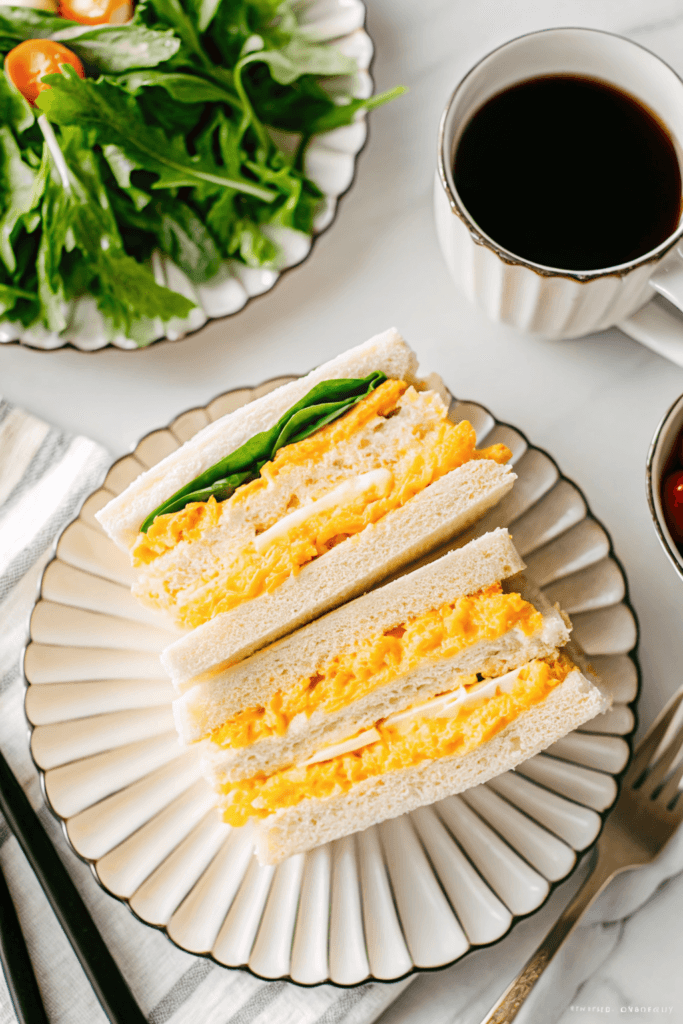
What Makes a Japanese Egg Sandwich Unique?
The Japanese egg sandwich—locally called Tamago Sando—is not just food, it’s an experience. Imagine ultra-soft white bread (shokupan), fluffy mashed boiled eggs, and rich, slightly sweet Kewpie mayo. Every bite melts in your mouth, delivering creamy, balanced flavors.
Core Characteristics:
- Shokupan Bread: Crustless, milk-based white bread with a soft, pillowy texture.
- Egg Filling: Hard-boiled eggs mashed to a smooth consistency (not chunky like Western egg salads).
- Kewpie Mayo: A Japanese mayonnaise that’s richer, slightly tangy, and bursting with umami.
- Visual Appeal: Always neat, uniform, and cut into perfect triangles or rectangles.
Why does this matter? Because Japanese food culture prizes balance, simplicity, and presentation. And the Tamago Sando ticks all three boxes beautifully.
Discover great ideas like this Carrot Cake Cookie recipe if you love delicately balanced flavors in your dishes.
History and Origins of the Japanese Egg Sandwich (Tamago Sando)
While sandwiches were Western imports, Japan made the egg sandwich its own in the mid-20th century. With the rise of convenience stores, or konbini, in the 1970s and ’80s, the Japanese egg sandwich became a go-to snack and lunch item for busy workers and students.
| Timeline | Key Milestone |
|---|---|
| Post-WWII | Western-style bread enters Japanese markets |
| 1960s | Rise of egg-based “yōshoku” (Western-style) dishes |
| 1980s | Convenience store boom; egg sandwiches hit shelves |
| 2000s | Kewpie mayo becomes a national obsession |
| 2020s | Tamago Sando goes viral globally on TikTok & Instagram |
And it’s not just about taste. There’s a sense of comfort and nostalgia built into every bite, especially for those who grew up in Japan.
Don’t miss our Strawberry Icebox Cake recipe for another iconic yet simple dish that thrives on presentation and creaminess.
Japanese Egg Sandwich vs. Western Egg Sandwich
Key Ingredient Differences
The Japanese egg sandwich and its Western counterpart both revolve around eggs and bread—but the similarities end there. Each sandwich tells a different cultural story through its ingredients and preparation.
Western-style egg sandwiches usually involve chopped eggs, crunchy vegetables like celery or onion, and a hefty spread of standard mayo, often Hellmann’s or a generic brand. The bread? Anything from whole wheat to rye or a bagel. They’re hearty and bold.
In contrast, the Japanese egg sandwich is minimalist and refined. The eggs are mashed to a nearly puréed consistency, folded with a generous scoop of Kewpie mayonnaise, which uses only egg yolks and a hint of rice vinegar, giving it a richer taste. The bread—shokupan—is a critical player, known for its soft, airy structure and mild sweetness.
Want to explore another rich, comforting dish? Discover our velvety natural Mounjaro recipe which, like Tamago Sando, prioritizes texture and mouthfeel.
Here’s a quick comparison:
| Feature | Japanese Egg Sandwich | Western Egg Sandwich |
|---|---|---|
| Bread | Shokupan (milk bread) | Multigrain, rye, bagel, or toast |
| Eggs | Mashed smooth | Chopped or sliced |
| Mayo | Kewpie (egg yolk-based) | Regular mayonnaise |
| Texture | Creamy and fluffy | Chunky and dense |
| Extras | Rarely includes add-ins | Often contains pickles, celery |
| Presentation | Crustless, neat triangles | Often rustic or stacked |
Texture, Flavor, and Presentation Comparison
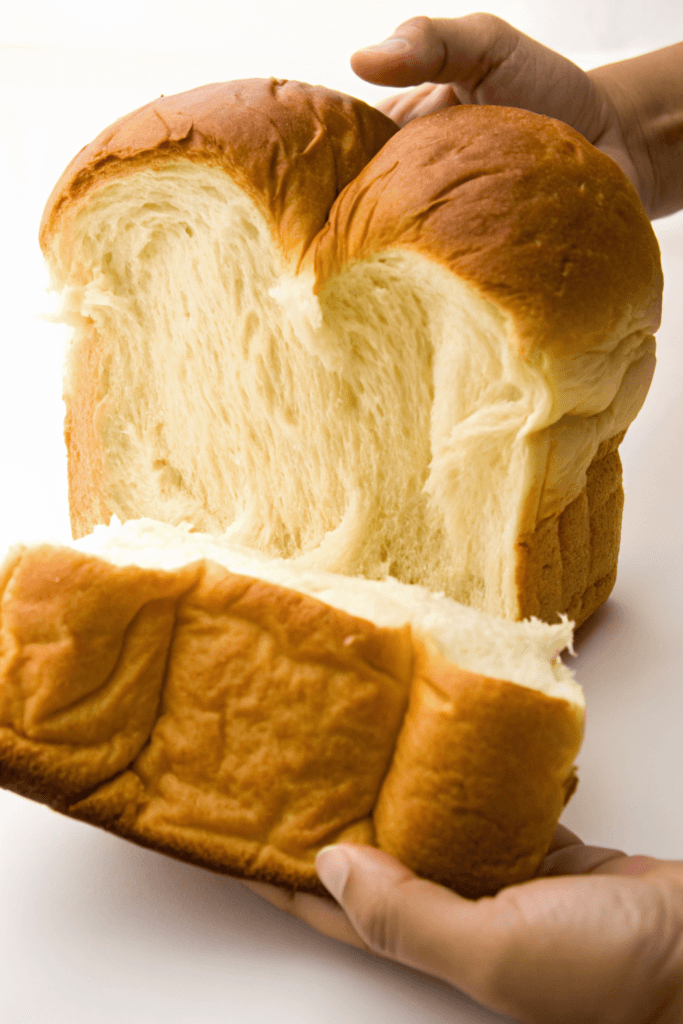
Texture is everything in a Japanese egg sandwich. The goal is seamless creaminess. Every bite should be consistent—no lumps, no random crunch, just buttery softness. This is the exact opposite of Western-style egg sandwiches, where texture is part of the charm.
Flavor-wise, Tamago Sando leans into subtlety. You won’t find mustard, black pepper, or paprika shouting for attention. Instead, the umami from Kewpie mayo and the sweetness of shokupan create a balanced, delicate profile. Think of it as comfort food, perfected.
The presentation of a Japanese egg sandwich is no accident. The crusts are removed. The shape is symmetrical. Even the egg mixture is often piped or carefully spread to ensure visual balance. In contrast, Western sandwiches often embrace mess—overflowing fillings and toasted edges are part of the appeal.
Looking for more dishes with a delicate balance? Check out this Strawberry Spinach Salad that layers flavors just as masterfully as a Tamago Sando.
The contrast isn’t about which is better—it’s about how each reflects its culture. One is loud and rugged, the other is quiet and refined.
And if you’re craving more uniquely structured comfort food, don’t miss our tasty Heaven on Earth cake, where form and flavor meet in sweet harmony.
Classic Japanese Egg Sandwich Recipe
Ingredients You Need for an Authentic Tamago Sando
To make an authentic Japanese egg sandwich at home, simplicity is key—but so is quality. With just a handful of ingredients, each component must be carefully selected. Traditional recipes rely on the balance of creamy, savory, and slightly sweet notes.
Here’s what you’ll need:
| Ingredient | Quantity | Notes |
|---|---|---|
| Large eggs | 4 | Boiled until yolks are just cooked |
| Kewpie mayonnaise | 3 tbsp | Japanese-style mayo for signature taste |
| Shokupan bread | 4 slices | Milk bread with crusts removed |
| Salt | 1/4 tsp | To taste |
| Sugar | 1/4 tsp | Optional—adds subtle sweetness |
| Butter (optional) | 1 tsp | Softened; for lightly buttering the bread |
Why Kewpie mayo? It contains only egg yolks (no whites), rice vinegar, and MSG—creating a deeper umami flavor compared to Western mayonnaise. Learn more about flavor pairings with our Brazilian Mounjaro recipe, which also relies on rich but balanced ingredients.
Step-by-Step Instructions (With Table of Measurements)
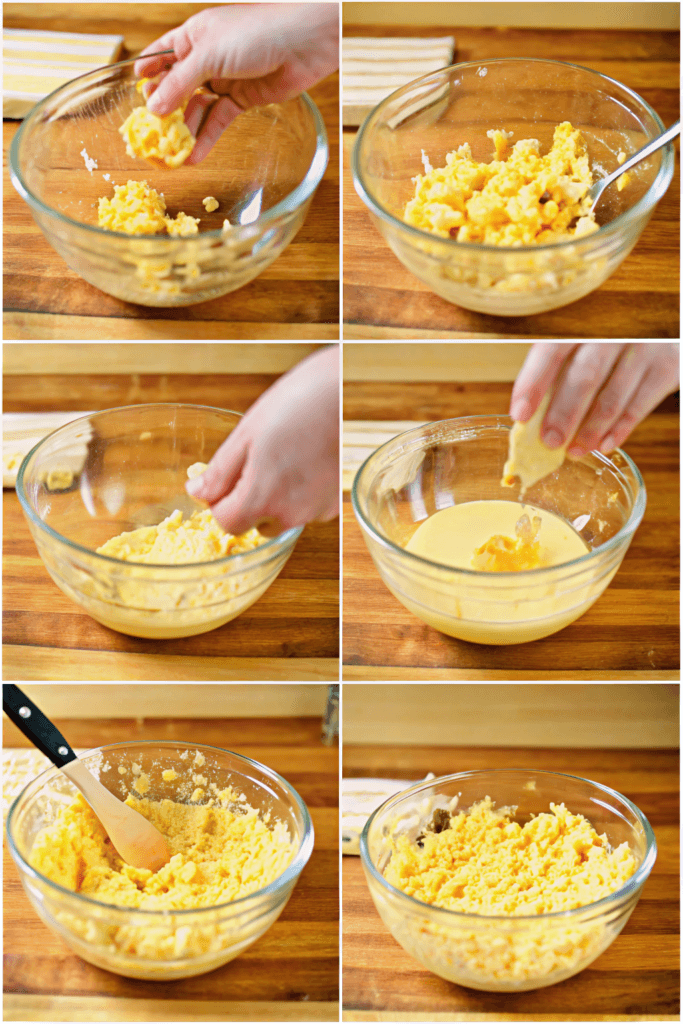
Follow these simple instructions to make a fluffy, restaurant-style Tamago Sando right from your kitchen.
- Boil the Eggs
Place eggs in a saucepan, cover with water, and bring to a boil. Reduce to a simmer and cook for 10 minutes. Transfer to an ice bath immediately after cooking. - Peel and Mash
Once cooled, peel the eggs and mash them in a bowl using a fork. Aim for a smooth, even texture—avoid leaving large chunks. - Mix in the Kewpie
Add 3 tablespoons of Kewpie mayonnaise, salt, and sugar (optional). Mix until fully blended into a creamy filling. - Prepare the Bread
Remove the crusts from the shokupan slices and spread butter lightly on one side if desired. - Assemble the Sandwich
Evenly spread the egg mixture on one slice and top with the second slice. Gently press and slice into halves or quarters. - Serve Immediately
Tamago Sando is best enjoyed fresh, slightly chilled, or at room temperature.
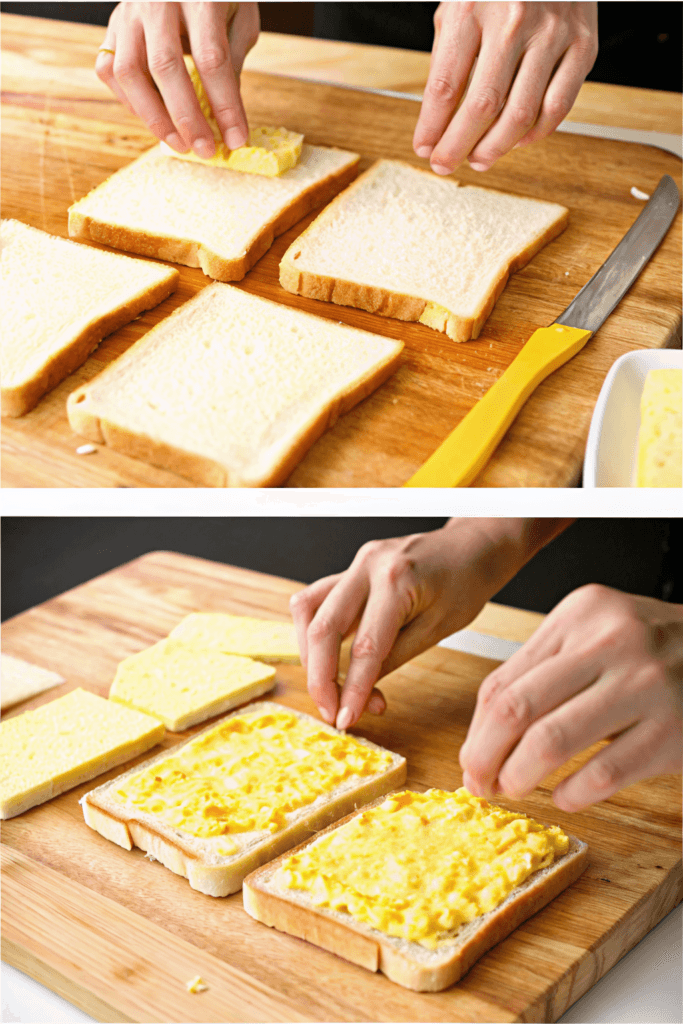
Here’s a quick prep guide:
| Step | Action | Duration |
|---|---|---|
| 1 | Boil eggs | 10 minutes |
| 2 | Cool and peel | 5 minutes |
| 3 | Mash and mix ingredients | 5 minutes |
| 4 | Prep bread and assemble | 5 minutes |
| 5 | Slice and serve | Immediate |
Looking for a sweet counterpoint to this rich, savory sandwich? Don’t miss our Strawberry Dole Whip—a tropical frozen treat that’s just as easy to whip up at home.
The Tamago Sando shines because it’s about harmony. Each ingredient plays its part without overwhelming the others. It’s a sandwich built on texture and taste memory.
Modern Variations of the Japanese Egg Sandwich
Kewpie Mayo Twist and Soft-Boiled Add-ons
While the classic Japanese egg sandwich thrives on its simplicity, modern chefs and home cooks are turning it into a creative playground. The foundational elements—shokupan, egg, and Kewpie mayo—remain, but new ingredients are being folded in for depth, texture, and style.
One of the most popular upgrades? Soft-boiled eggs. Instead of fully mashing all the eggs, some versions place a soft-boiled egg with a gooey center in the middle of the sandwich. When you bite into it, the yolk oozes out, creating an incredibly satisfying texture contrast.
Other unique variations include:
- Wasabi or yuzu zest for a citrusy kick
- Grated parmesan or smoked paprika for a flavor punch
- Egg yolk-only fillings for richness
- Truffle oil or garlic butter added to the mayo
You can even swap out plain shokupan for a charcoal bread or brioche if you’re feeling adventurous.
Discover great ideas like our Caramel Turtle Poke Cake if you love indulgent spins on classic favorites—just like how Tamago Sando has evolved.
Gourmet and Street Food Takes on Tamago Sando
In Japan, you’ll find gourmet Tamago Sandos in high-end cafés, where they’re layered with microgreens, cured yolks, or dusted with edible flowers. These upscale versions focus on elevating the sandwich into an artisanal product.
Meanwhile, street food stalls have embraced bolder fillings—think egg mixed with crab meat, shrimp tempura, or even a dash of curry powder. The sandwich evolves based on local tastes, while still maintaining its foundational identity.
Here are some modern Tamago Sando variations gaining traction:
| Version | Key Additions |
|---|---|
| Café Style | Dill, cured yolk, edible flowers |
| Street Food Inspired | Tempura shrimp, curry mayo |
| Fusion | Kimchi egg salad, spicy miso aioli |
| High-Protein | Chopped tofu, egg whites, Greek yogurt |
Looking for inspiration? Try our 7 Amazing Gluten-Free Ice Cream Recipes to discover how tradition and modern tastes can blend seamlessly.
If you enjoy sweet-savory combos, don’t miss our Chocolate Chip Cookie Recipe Without Brown Sugar, which—like Tamago Sando—is all about reimagining staples with smart tweaks.
The modern Japanese egg sandwich proves one thing: simplicity doesn’t mean limitation. With a few thoughtful upgrades, Tamago Sando can adapt to any palette or occasion.
Nutrition and Health Profile
Is the Japanese Egg Sandwich Healthy?
The Japanese egg sandwich may look indulgent, but its nutritional value can surprise you. Compared to fast-food breakfast sandwiches loaded with preservatives, processed cheese, and sausage, Tamago Sando is relatively clean. It’s made with simple, real ingredients—eggs, shokupan, and Kewpie mayonnaise.
Let’s break it down. A standard Japanese egg sandwich contains roughly:
- Calories: 320–380 (depending on portion size and mayo quantity)
- Protein: 10–12g
- Fat: 20–25g (mostly from eggs and Kewpie)
- Carbs: 25–30g (from white bread)
- Sugar: 2–3g
- Fiber: 1g
Here’s a quick nutritional overview:
| Nutrient | Amount per Sandwich | Source |
|---|---|---|
| Calories | 350 kcal | Eggs, mayo, bread |
| Protein | 11g | Eggs |
| Total Fat | 23g | Egg yolks, Kewpie mayo |
| Carbohydrates | 28g | Shokupan bread |
| Sodium | 470mg | Mayo, added salt |
Despite its richness, the Japanese egg sandwich provides good quality protein and healthy fats. The use of Kewpie mayo, which includes rice vinegar and egg yolks, offers a deeper flavor, meaning you need less of it for more taste—an advantage for portion control.
If you’re watching your intake, there are easy modifications:
- Use low-fat or Greek yogurt-based mayo
- Substitute one egg with firm tofu
- Opt for whole wheat shokupan or crust-on slices for added fiber
Want more balanced meal ideas? Discover our Mounjaro-Friendly Meals Guide packed with protein-smart recipes.
Calorie Breakdown and Protein Content (With Table)
To truly understand the value of a Japanese egg sandwich, it helps to examine each element. Here’s how the calories and macronutrients stack up by component:
| Component | Calories | Protein | Fat | Carbs |
|---|---|---|---|---|
| 2 Eggs | 140 | 12g | 10g | 1g |
| Kewpie Mayo (1 tbsp) | 100 | 0g | 11g | 0g |
| Shokupan (2 slices) | 110 | 3g | 2g | 27g |
That makes the Japanese egg sandwich not just tasty, but a flexible snack or light meal depending on your nutritional needs.
Planning a calorie-conscious treat next? You’ll love our Strawberry Cheesecake Cookies—sweet, balanced, and perfectly portioned.
From the gym-goer to the on-the-go mom, Tamago Sando fits into many lifestyles. Just be mindful of portion size and pair it with water, green tea, or miso soup for a complete experience.
Where to Find Japanese Egg Sandwiches
Popular Places in Japan and Abroad
If you’re visiting Japan, there’s no excuse not to try a Japanese egg sandwich firsthand. It’s everywhere—from airport terminals to tiny local bakeries. But where can you get the best Tamago Sando experience? The answer often lies in two very different places: convenience stores and upscale cafés.
In Japan, convenience stores (konbini) like 7-Eleven, Lawson, and FamilyMart stock fresh, perfectly cut Japanese egg sandwiches daily. These pre-packaged delights are known for their surprisingly high quality, often rivalling restaurant versions in taste and texture.
For a more gourmet experience, you’ll want to visit specialty cafés such as:
- Konbini Café – Tokyo’s premium sandwich shop inspired by convenience food.
- Tamago & Toast – A popular Kyoto café serving fusion-style egg sandwiches.
- Sando Lab – Osaka’s famous sandwich bar known for soft-boiled Tamago Sando with microgreens.
Can’t get to Japan? The Japanese egg sandwich has made its way to the U.S., UK, and Australia. Many Japanese bakeries, Asian fusion cafés, and even gourmet food trucks now serve elevated versions. You can often find them in larger cities like New York, San Francisco, and London.
Looking for other fusion food ideas? Don’t miss our Taro Flavored Pancake Recipe, which blends traditional Asian ingredients with breakfast staples.
Japanese Convenience Stores vs. Cafés: What’s the Difference?
While Japanese egg sandwiches from konbini and cafés may look similar, they offer different experiences.
Here’s how they compare:
| Feature | Convenience Store Version | Café or Gourmet Version |
|---|---|---|
| Price | ¥250–¥350 | ¥600–¥1200 |
| Bread Quality | Soft but mass-produced | Often homemade or premium shokupan |
| Filling Texture | Smooth and uniform | Creamy with gourmet add-ons |
| Mayo Used | Standard Kewpie | Flavored or house-made mayo |
| Presentation | Vacuum-sealed, triangle-cut | Plated, sometimes with garnish |
The konbini version is fast, cheap, and reliable—ideal for on-the-go breakfast or lunch. The café version, meanwhile, turns the Japanese egg sandwich into an artisanal experience that’s worth savoring slowly.
If you’re exploring iconic, easy-to-recreate dishes at home, don’t miss our Coconut Macaroons Recipe. Like Tamago Sando, it’s a minimalist favorite done right.
For a guide to another wildly popular Japanese food trend, check out our deep dive on Sweet Potato Tempura Rolls—crispy, sweet, and irresistible.
The spread of the Japanese egg sandwich beyond Japan speaks to its universal appeal: comfort, elegance, and crave-worthy flavor all in one bite.
How to Make the Perfect Japanese Egg Sandwich at Home
Common Mistakes to Avoid
Mastering the Japanese egg sandwich at home sounds simple, but a few small missteps can turn this creamy dream into a soggy mess. Here are the most common mistakes—and how to avoid them.
- Using the Wrong Bread
Not all white bread is created equal. Standard supermarket sandwich loaves won’t deliver the cloud-like texture of shokupan, Japan’s milk bread. If you can’t find authentic shokupan, opt for brioche or make your own with milk, yeast, and a touch of sugar. - Overcooking the Eggs
A dry yolk leads to a dry sandwich. Boil the eggs just until set—about 10 minutes—then transfer to an ice bath immediately to halt cooking and preserve a velvety texture. - Using Too Much Mayo or the Wrong Kind
Standard mayo lacks the depth and umami of Kewpie mayo. Overusing it can also make your filling runny. Stick with 2–3 tablespoons per 4 eggs. - Skipping the Salt
Even though Kewpie mayo is flavorful, you still need a pinch of salt to enhance the eggs. Taste as you go. - Rushing the Chill Time
Letting your assembled Japanese egg sandwich sit in the fridge for 30 minutes helps the flavors meld and firms up the filling—especially important for clean slicing.
Want to avoid other kitchen mistakes? Check out our tips in this Chef John’s Perfect Prime Rib guide—a great example of how temperature control and timing change everything.
Pro Tips for Fluffy Texture and Balanced Flavor
If you want your homemade Japanese egg sandwich to rival those from Tokyo cafés or Lawson konbini stores, you’ll need to refine the details.
- Mash the eggs with a fork or sieve
Avoid food processors. You want a light mash that still holds together. - Use cold eggs for easier peeling
Ice-bathing immediately after boiling prevents overcooking and makes peeling clean and easy. - Add a splash of cream or milk
For an ultra-luxurious texture, fold in a teaspoon of heavy cream to your egg mixture. - Rest before slicing
Refrigerate the sandwich for 15–30 minutes before cutting. This firms up the filling and creates clean edges. - Cut with a serrated knife
Especially important when using thick or homemade bread, a serrated knife won’t crush the soft texture.
Bonus tip: Want to elevate your sandwich with a sweet twist? Pair it with our Madeline Cookies Recipe Using Cream—a refined, delicate dessert that won’t overpower the subtle egg flavors.
Mastering Tamago Sando at home doesn’t take chef-level skills, just a bit of care, the right ingredients, and attention to detail.
Japanese Egg Sandwich in Pop Culture
TV Shows, Anime, and Films Featuring Tamago Sando
The Japanese egg sandwich isn’t just a viral snack—it’s a cultural icon that’s made its way into anime, films, variety shows, and cooking competitions. Why? Because it embodies the elegance of Japanese minimalism and the warmth of home cooking, all in a tiny, crustless package.
You’ll spot Tamago Sando in:
- Anime like “Shokugeki no Soma” (Food Wars!) where detailed egg dishes highlight Japanese culinary pride.
- Japanese dramas such as “Midnight Diner” where food tells emotional stories—often through nostalgic, simple meals like egg sandwiches.
- Documentaries and travel shows that highlight konbini culture, often praising the flawless texture and packaging of Japanese egg sandwiches found at FamilyMart or Lawson.
Even international food icons like Anthony Bourdain and David Chang have praised this sandwich on their global tours. It’s consistently referred to as “a perfectly executed piece of comfort food.”
Need another food with cultural roots and mass appeal? Don’t miss our Ultimate Guide to the Nestlé Chocolate Chip, a Western counterpart to Japan’s comfort classics.
Why It Became a Viral Trend on TikTok and Instagram
On platforms like TikTok and Instagram, the Japanese egg sandwich has become a viral sensation. Why? Because it looks perfect. Smooth, symmetrical, and satisfying, it’s ideal for visual storytelling.
Creators showcase:
- Perfect slicing videos, where soft-boiled yolks ooze out like lava
- Aesthetic meal prep reels, pairing Tamago Sando with matcha lattes
- Bento box assemblies, often starring Tamago Sando front and center
The clean cuts and creamy layers make for viral ASMR content, while the ease of making one adds to its popularity among food influencers and home chefs alike.
Here’s why social media loves Tamago Sando:
| Reason | Impact |
|---|---|
| Visual Perfection | Clean lines, bright color contrast |
| Simplicity | Few ingredients, easy to explain |
| Comfort Factor | Feels nostalgic, even if it’s new |
| Trend Alignment | Matches minimalist, wellness aesthetics |
Looking for more viral-worthy recipes? Try our Chocolate Ice Cream Cone Guide, which also balances photogenic presentation with pure indulgence.
And if you’re into recipes that are as soothing to make as they are to eat, check out our Creamy Parmesan Italian Sausage Soup—comfort food at its most click-worthy.
The rise of the Japanese egg sandwich across media is proof that in an era of over-the-top culinary creations, simplicity still reigns supreme.
Pairing Suggestions & Serving Ideas
Drinks and Sides That Complement It Best
The creamy, mellow flavor of a Japanese egg sandwich makes it incredibly versatile. Whether you’re packing a bento, serving brunch, or enjoying a midday snack, pairing it with the right drinks and sides can elevate the experience.
Here are perfect drink pairings:
- Iced matcha latte – The bitterness of matcha balances the sandwich’s richness
- Green tea (hot or cold) – Cleanses the palate without overpowering the flavor
- Soy milk or oat milk – Light and neutral, they complement the egg and bread
- Fruit smoothies – Strawberry or banana smoothies add a refreshing sweet contrast
Ideal sides to pair with a Japanese egg sandwich:
- Light salads – A crisp cucumber or radish salad with sesame dressing works wonders
- Miso soup – Brings warmth and umami to a soft, chilled sandwich
- Fruit slices – Kiwi, apple, or citrus provide brightness
- Pickled veggies – A small serving of Japanese pickles adds a needed tang
Want to explore more light, refreshing recipes? Don’t miss our Winter Fruit Salad—perfect for balancing the creamy richness of Tamago Sando.
Bento Box Inspiration and Picnic Ideas
The Japanese egg sandwich is a star player in modern bento boxes. Its clean shape and vibrant filling make it a practical and aesthetic choice for meal prep.
Here’s how to build a perfect Tamago Sando Bento Box:
| Item | Description |
|---|---|
| Tamago Sando | Cut into neat triangles or halves |
| Cherry tomatoes | Add color and a burst of acidity |
| Fruit (e.g., orange slices) | Fresh, juicy, and sweet |
| Mini salad cup | Mixed greens with sesame or citrus dressing |
| Sweet treat | A small matcha cookie or mochi |
For picnics, wrap your Japanese egg sandwich in wax paper and secure with string. Keep cool in an insulated lunch bag, and serve with sparkling water, pickled vegetables, and fruit. It’s elegant, mess-free, and universally loved.
Planning more cozy meals? Our Chicken Marry Me Recipe makes a great hearty companion dish if you’re prepping a full spread for guests.
If you’re in the mood for a cheesy twist on tradition, explore our savory Brunch Casserole Without Eggs—a great eggless balance to pair alongside Tamago Sando.
Whether it’s a quiet solo lunch or an Instagram-worthy picnic, the Japanese egg sandwich fits the occasion. Thoughtful pairing turns it from simple to sublime.
Frequently Asked Questions About Japanese Egg Sandwich
What’s in a Japanese egg sandwich?
A traditional Japanese egg sandwich—known as Tamago Sando—consists of just a few key ingredients: soft-boiled or hard-boiled eggs, Kewpie mayonnaise, a pinch of salt, and shokupan (Japanese milk bread). The eggs are mashed to a smooth consistency and blended with the mayo to create a creamy, flavorful filling that’s layered between two slices of crustless white bread. Some versions include soft-boiled eggs in the center for a luxurious, runny yolk effect.
Why is Japanese egg sandwich so good?
It’s all about texture and flavor balance. The Japanese egg sandwich is beloved for its pillowy soft bread, silky egg mixture, and umami-rich Kewpie mayo. The sandwich is served chilled or at room temperature, enhancing its creaminess and delicate structure. It’s comforting, satisfying, and refined all at once—making it universally appealing.
What is a traditional Japanese sandwich?
In Japan, sandwiches are called sando and are typically made using shokupan (milk bread). Besides the Japanese egg sandwich, other traditional sandos include katsu sando (pork cutlet), fruit sando (filled with whipped cream and fresh fruit), and potato salad sando. These sandwiches focus on soft textures, minimal ingredients, and visual neatness.
What is in a Sando sandwich?
“Sando” is a Japanese abbreviation of “sandwich,” and a Sando sandwich refers to any sandwich made in the Japanese style. It usually features shokupan, is crustless, and packed with well-prepared, flavorful fillings. In the case of Tamago Sando, the key ingredients are mashed eggs and Kewpie mayo. Other types may include fried meat, egg salad, or even sweet fillings like cream and fruit.
Conclusion: Why the Japanese Egg Sandwich Deserves a Spot in Your Kitchen
The Japanese egg sandwich isn’t just another breakfast option—it’s a culinary icon wrapped in simplicity. Whether you first encountered it in a konbini in Tokyo, a trendy NYC café, or while scrolling through your TikTok feed, there’s no denying its appeal.
From its ultra-smooth texture and rich umami flavor to its elegant, no-fuss appearance, the Tamago Sando proves that the best food doesn’t need to shout. It whispers quality through every bite. With just a few ingredients and a little care, you can bring this Japanese staple into your home and make it your own.
Looking for inspiration? Try our Chocolate Covered Caramels Recipe to end your Tamago Sando experience on a sweet note.
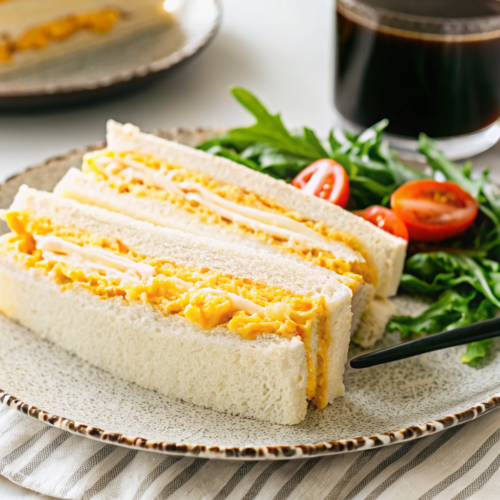
Classic Japanese Egg Sandwich (Tamago Sando)
Equipment
- Medium saucepan (for boiling eggs)
- Mixing bowl
- Fork or potato masher (for mashing eggs)
- Spoon or spatula (for mixing and spreading)
- Bread knife or serrated knife (for clean slicing)
- Cutting board
- Optional: Fine mesh sieve (for extra-smooth egg texture)
- Optional: Butter knife (if buttering bread)
Ingredients
- 4 large eggs hard-boiled
- 3 tbsp Kewpie mayonnaise
- 1/4 tsp salt or to taste
- 1/4 tsp sugar optional
- 4 slices shokupan Japanese milk bread, crusts removed
- 1 tsp butter optional, softened for spreading
Instructions
- Boil the Eggs: Place eggs in a saucepan, cover with water, and bring to a boil. Reduce heat and simmer for 10 minutes. Transfer immediately to an ice bath to cool completely.
- Peel and Mash: Peel the cooled eggs and mash them in a bowl with a fork until smooth and lump-free.
- Mix the Filling: Add Kewpie mayo, salt, and sugar (if using) to the mashed eggs. Stir until creamy and fully combined.
- Prepare the Bread: Remove crusts from the shokupan slices. Lightly butter one side of each slice if desired.
- Assemble the Sandwich: Spread the egg mixture evenly onto two slices of bread. Top with the remaining slices. Press gently to seal.
- Slice and Serve: Cut the sandwiches into halves or neat quarters. Serve chilled or at room temperature.

